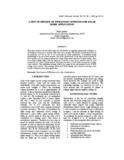| dc.contributor.author | Akhter, Rafia | |
| dc.date.accessioned | 2010-10-07T03:53:54Z | |
| dc.date.available | 2010-10-07T03:53:54Z | |
| dc.date.issued | 2007 | |
| dc.identifier.uri | http://hdl.handle.net/10361/361 | |
| dc.description.abstract | This paper analyzes the procedural approach and benefits of applying optimization techniques to the design of a boost dc-ac converter with solar cell as an input. The analysis is performed based on the particular 12V DC to 220 V AC conversion for home applications. A traditional design methodology is the use of buck inverter. One of the characteristics of the most classical inverter is that it produces an AC output instantaneous voltage always lower than the DC input voltage. Thus, if an output voltage higher than the input one is needed, a boost dc-dc converter must be used between the DC source and the inverter. This paper describes a new P.W.M. strategy for a voltage source inverter. This modulation strategy reduces the energy losses and harmonics in the P.W.M. voltage source inverter. This technique allows the P.W.M. voltage source inverter to become a new feasible solution for solar home application. | en_US |
| dc.language.iso | en | en_US |
| dc.publisher | BRAC University | en_US |
| dc.relation.ispartofseries | BRAC University Journal, BRAC University;Vol.4. No. 1 pp. 39-45 | |
| dc.subject | Boost Inverter | en_US |
| dc.subject | PWM | en_US |
| dc.subject | Duty cycle | en_US |
| dc.subject | Solar cell | en_US |
| dc.subject | inverter | en_US |
| dc.title | A new technique of PWM boost inverter for solar home application | en_US |
| dc.type | Article | en_US |

